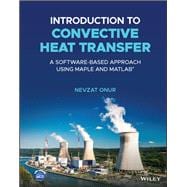A highly practical intro to solving real-world convective heat transfer problems with MATLAB® and MAPLE
In Introduction to Convective Heat Transfer, accomplished professor and mechanical engineer Nevzat Onur delivers an insightful exploration of the physical mechanisms of convective heat transfer and an accessible treatment of how to build mathematical models of these physical processes.
Providing a new perspective on convective heat transfer, the book is comprised of twelve chapters, all of which contain numerous practical examples. The book emphasizes foundational concepts and is integrated with explanations of computational programs like MATLAB® and MAPLE to offer students a practical outlet for the concepts discussed within. The focus throughout is on practical, physical analysis rather than mathematical detail, which helps students learn to use the provided computational tools quickly and accurately.
In addition to a solutions manual for instructors and the aforementioned MAPLE and MATLAB® files, Introduction to Convective Heat Transfer includes:
- A thorough introduction to the foundations of convective heat transfer, including coordinate systems, and continuum and thermodynamic equilibrium concepts
- Practical explorations of the fundamental equations of laminar convective heat transfer, including integral formulation and differential formulation
- Comprehensive discussions of the equations of incompressible external laminar boundary layers, including laminar flow forced convection and the thermal boundary layer concept
- In-depth examinations of dimensional analysis, including the dimensions of physical quantities, dimensional homogeneity, and dimensionless numbers
Ideal for first-year graduates in mechanical, aerospace, and chemical engineering, Introduction to Convective Heat Transfer is also an indispensable resource for practicing engineers in academia and industry in the mechanical, aerospace, and chemical engineering fields.









